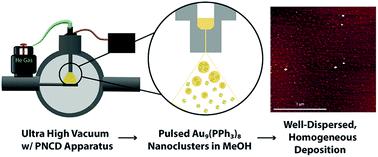当前位置:
X-MOL 学术
›
Nanoscale Adv.
›
论文详情
Our official English website, www.x-mol.net, welcomes your feedback! (Note: you will need to create a separate account there.)
Sub-monolayer Au9 cluster formation via pulsed nozzle cluster deposition
Nanoscale Advances ( IF 4.7 ) Pub Date : 2020-07-20 , DOI: 10.1039/d0na00566e Jesse Daughtry 1, 2 , Gunther G Andersson 1, 2 , Gregory F Metha 3 , Siriluck Tesana 4 , Tomonobu Nakayama 5
Nanoscale Advances ( IF 4.7 ) Pub Date : 2020-07-20 , DOI: 10.1039/d0na00566e Jesse Daughtry 1, 2 , Gunther G Andersson 1, 2 , Gregory F Metha 3 , Siriluck Tesana 4 , Tomonobu Nakayama 5
Affiliation

|
Submonolayer coverages of chemically synthesised triphenylphosphine-protected Au9 clusters on mica and TiO2 substrates were achieved through the development of a Pulsed Nozzle Cluster Deposition (PNCD) technique under high vacuum conditions. This method offers the deposition of pre-prepared, solvated clusters directly onto substrates in a vacuum without the potential for contamination from the atmosphere. AFM and TEM were used to investigate the rate of gold cluster deposition as a function of cluster solution concentration and the number of pulses, with pulse number showing the most effective control of the final deposition conditions. TEM and XPS were used to determine that the clusters retained their unique properties through the deposition process. Methanol solvent deposited in the PNCD process has been shown to be removable through post-deposition treatments. A physical model describing the vapour behaviour and solvent evaporation in a vacuum is also developed and presented.
中文翻译:

通过脉冲喷嘴簇沉积形成亚单层 Au9 簇
云母和 TiO 2上化学合成的三苯基膦保护的 Au 9簇的亚单层覆盖通过在高真空条件下开发脉冲喷嘴簇沉积 (PNCD) 技术来实现基板。这种方法可以在真空中将预先制备的溶剂化簇直接沉积到基材上,而不会受到大气污染。AFM 和 TEM 用于研究金簇沉积速率与簇溶液浓度和脉冲数的关系,其中脉冲数显示对最终沉积条件的最有效控制。TEM 和 XPS 用于确定簇通过沉积过程保留了其独特的性质。已证明在 PNCD 工艺中沉积的甲醇溶剂可通过沉积后处理去除。
更新日期:2020-09-16
中文翻译:

通过脉冲喷嘴簇沉积形成亚单层 Au9 簇
云母和 TiO 2上化学合成的三苯基膦保护的 Au 9簇的亚单层覆盖通过在高真空条件下开发脉冲喷嘴簇沉积 (PNCD) 技术来实现基板。这种方法可以在真空中将预先制备的溶剂化簇直接沉积到基材上,而不会受到大气污染。AFM 和 TEM 用于研究金簇沉积速率与簇溶液浓度和脉冲数的关系,其中脉冲数显示对最终沉积条件的最有效控制。TEM 和 XPS 用于确定簇通过沉积过程保留了其独特的性质。已证明在 PNCD 工艺中沉积的甲醇溶剂可通过沉积后处理去除。



























 京公网安备 11010802027423号
京公网安备 11010802027423号